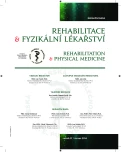Objectification of the Importance of Beating Exercise in Subjects with Spinal Cord Injury
Authors:
A. Vetkasov; B. Hošková; I. Sobotková
Authors‘ workplace:
Katedra zdravotní tělesné výchovy a tělovýchovného lékařství FTVS UK, Praha
vedoucí katedry doc. PhDr. B. Hošková, CSc.
Published in:
Rehabil. fyz. Lék., 21, 2014, No. 2, pp. 68-72.
Category:
Original Papers
Overview
It is known, from clinical practice and research, that breathing exercises have a positive effect on people with spinal cord injury (SCI). The purpose of this study was to perform special breathing exercises in persons with SCI and evaluate their effectiveness by using X-ray of lungs and other tests. Sample consisted of 15 respondents with SCI, 8 men and 7 women, mostly middle-aged and elderly. Intervention program took 6 months, with the frequency of exercise five times a week, in the range of 20-30 minutes. The study has included: 1 ) Chest X-Ray in a sitting position during inhalation and exhalation; 2) chest excursion; 3) determination of forced vital capacity (FVC) and forced expiratory volume during the first second (FEV1 ); 4) measurement of respiratory rate. Pretest X-ray showed that the difference between the movement of the lower ribs during inhalation and exhalation was 2-35 mm. Measurement of chest circumference showed a limitation of chest expansion related to normal values corrected with age and sex. Tetraplegic patient’s FVC decreased by 30-50 % compared with the values of healthy population and paraplegics FVC reduced about 80 %. Respiratory rate was 13 to 22 breaths/ min. for all respondents with SCI. We have repeated the tests after six months. X-ray examination showed that the difference between the movement of the lower ribs during inhalation and exhalation has increased by 49% (6 to 45 mm). It has become obvious that circumference of the chest during inspiration increased by 3.5 % and chest circumference during exhalation decreased by 1.27%. One-second vital capacity increased by 5.68% and forced vital lung capacity by 7.61 %. Respiratory rate decreased on average by 16.22 %. In this study, by using X-ray and other tests, we have noticed the objective influence of breathing exercises on the respiratory muscles in persons with SCI.
Keywords:
breathing exercise, spinal cord injury, X-ray
Sources
1. AIYAR, H., STELLATO, T. A., ONDRES, R. P., MORTIMER, J. T.: Laparoscopic implant instrument for the placement of intramuscular electrodes in the diaphragm. IEEE Trans. Rehabil. Eng,, 7, 1999, 3, s. 360-371.
2. BROWN, R., ANTHONY, F.: Respiratory dysfunction and management in spinal cord injury. DiMarco M. D., Jeannette D., Hoit PhD CCC-SLP, and Eric Garshick MD MOH Respir Care, 2006, 51, 8, s. 853 - 868.
3. ČUMPELÍK, J., VÉLE, F., KROBOT, A. aj.: Vztah mezi dechovými pohyby a držením těla. Rehabilitace a fyzikální lékařství, 2006, č. 2, s. 62-70.
4. VETKASOV, A., HOŠKOVÁ, B.: Vliv dechových cvičení u zdravotně postižených s poškozením míchy. Aplikované pohybové aktivity v teorii a praxi, 2013, č. 4 (1), s. 31-38.
5. GROSS, D., LADD, H. W., RILEY, E. J., MACKLEM, P. T., GRASSINO, A.: The effect of training on strength and endurance of the diaphragm in quadriplegia. Am. J. Med., 68, 1980,1, s. 27-35.
6. HODGES, P. W., GANDEIVA, S. C.: Activation of the human diaphragm during a repetitive postural task. Journal of Physiology, 522, 2000. 1, s. 165-175.
7. KOGAN, I., McCOOL, F. D., LIBERMAN, S. L., GARSHICK, E., SHANNON, K., FRISBEE, J. H., BROWN, R.: Diaphragm hypertrophy during inspiratory muscle training in tetraplegia (abstract). Am. J. Respir. Crit. Care Med., 153, 1996, 4, A25.
8. LEITH, D. R., BRADLEY, M.: Ventilatory muscle strength and endurance training. J. Appl. Physiol., 41, 1976, 4, s. 508-516.
9. LOH, L. GOLDMAN, M., NEWSON-DAVIS, J.: The assessment of diaphragm function. Medicine, 56, 1977, s. 165-169.
10. LOKE, J., MAHLER, D. A., VIRGULTO, J. A.: Respiratory muscle fatigue after marathon running. J. Appl. Physiol,, 52, 1982, 4, s. 821-824.
11. MANNING, H., McCool, F. D., SCHARF, S. M., GARSHICK, E., BROWN, R.: Oxygen cost of resistive-loaded breathing in quadriplegia. J. Appl.Physiol,, 73, 1992, 3, s. 825-831.
12. ONDRES, R. P., DiMARCO, A. F., IGNAGNI, A. R., AIYAR, H., MORTIMER, J. T.: Mapping the phrenic nerve motor point: the key to a successful laparoscopic diaphragm pacing system in the first human series. Surgery, 136, 2004, 4, s. 819–826.
13. RUTCHIK, A., WEISSMAN, A. R., ALMENOFF, P. L., SPUNGEN, A. M., BAUMAN, W. A., GRIMM, D. R.: Resistive inspiratory muscle training in subjects with chronic cervical spinal cord injury. Arch. Phys. Med. Rehab., 79, 1998, 3, s. 293-297.
14. SKLÁDAL, J., ŠKAVRAN, K., MIKULENKA, V.: Posturální funkce bránice. Čs. Fysiol, 19, 1970, s. 279-280.
15. STELLATO, T. A., PETERSON, D. K., BUEHNER, P., NOCHOMOVITZ, M. L., MORTIMER, J. T.: Taking the laparoscope to the laboratory for ventilatory research. Am. Surg., 56, 1990, 3, s. 131-133).
16. UIJL, S. G., HOUTMAN, S., FOLFERNING, H. T., HOPMAN, M. T.: Training of the respiratory muscles in individuals with tetraplegia. Spinal Cord, 37, 1999, 8, s. 575-579.
17. VELÉ, F.: Kineziologie. Přehled klinické kineziologie a patokineziologie pro diagnostiku a terapii poruch pohybové soustavy, Praha, 2006.
Labels
Physiotherapist, university degree Rehabilitation Sports medicineArticle was published in
Rehabilitation & Physical Medicine

2014 Issue 2
Most read in this issue
- Differential Diagnostics of „Scapula Alata”
- Evaluation of Postural Stability Using Functional Tests in a Group of Subjects with Transtibial Amputation (A Pilot Study)
- Electroencephalographic Correlates of Performance Motivation and Fatigue
- Rehabilitation Method KLIM-THERAPY – Reflections on the Mechanisms of Clinical Effect
